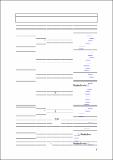Por favor, use este identificador para citar o enlazar a este item:
http://hdl.handle.net/10261/158076COMPARTIR / EXPORTAR:
 SHARE SHARE
 CORE
BASE CORE
BASE
|
|
| Visualizar otros formatos: MARC | Dublin Core | RDF | ORE | MODS | METS | DIDL | DATACITE | |

| Título: | Mass spectrometry: the indispensable tool for plant metabolomics of colourless chlorophyll catabolites |
Autor: | Roca, María CSIC ORCID ; Ríos Martín, José Julián CSIC ORCID; Pérez Gálvez, Antonio CSIC ORCID | Palabras clave: | Chlorophyll catabolism Mass spectrometry Phyllobilins Structure elucidation |
Fecha de publicación: | 18-nov-2017 | Editor: | Springer Nature | Citación: | Phytochemistry Reviews 17 (2): 453–468 (2018) | Resumen: | Senescence and ripening of plant tissues engage the pheophorbide a oxygenase pathway, reducing the chlorophyll content to inactive chlorophyll catabolite products, termed phyllobilins. These products are open-macrocycle derivatives, but present different structural features related to species-dependent enzyme activity. This review encompasses a brief outline of the chlorophyll catabolism pathway, a detailed description of the structural motifs of known phyllobilins, giving details of how mass spectrometry provides hints for the characterization of phyllobilins. The structural approach for the identification of phyllobilins requires several spectroscopic methodologies to reach a complete structural identification, including UV–visible spectroscopy, circular dichroism, nuclear magnetic resonance and mass spectrometry. Among these techniques, mass spectrometry presents several advantages for showing the structural features of phyllobilins, through acquisition of accurate mass, elemental composition, and detection of product ions, which provide valuable structural information. The combination of mass spectra with data-managing and in silico prediction tools greatly enhances the comprehensive building of the phyllobilin structure, and the resolving of the intriguing puzzle of enzymatic and chemical reactions involved in chlorophyll catabolism. Indeed, some strategies based on structural constraints that phyllobilins present, with recent developments in software prediction tools are proposed to foster the unravelling of phyllobilin structures. | Descripción: | Artículo principal: 26 Páginas; Tablas y Fuguras: 13 P´ginas; 7 Figuras; 2 Tablas | Versión del editor: | http://dx.doi.org/10.1007/s11101-017-9543-z | URI: | http://hdl.handle.net/10261/158076 | DOI: | 10.1007/s11101-017-9543-z | ISSN: | 1568-7767 | E-ISSN: | 1572-980X |
| Aparece en las colecciones: | (IG) Artículos |
Ficheros en este ítem:
| Fichero | Descripción | Tamaño | Formato | |
|---|---|---|---|---|
| Postprint_2017_PhytochemRev_.pdf | Artículo principal | 290,82 kB | Adobe PDF |  Visualizar/Abrir |
| Postprint_2017_PhytochemRev_Fig_Tab.pdf | Figuras y Tablas | 492,17 kB | Adobe PDF |  Visualizar/Abrir |
CORE Recommender
SCOPUSTM
Citations
12
checked on 17-abr-2024
WEB OF SCIENCETM
Citations
11
checked on 20-feb-2024
Page view(s)
273
checked on 17-abr-2024
Download(s)
453
checked on 17-abr-2024
Google ScholarTM
Check
Altmetric
Altmetric
NOTA: Los ítems de Digital.CSIC están protegidos por copyright, con todos los derechos reservados, a menos que se indique lo contrario.
